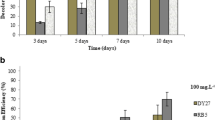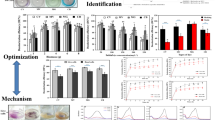Abstract
Herein, we systematically reported the capability of T. harzianum RY44 for decolorization of Mordant orange-1. The fungi strains were isolated from the Universiti Teknologi Malaysia tropical rain forest. For initial screening, the decolorization was conducted using 50 strains of the fungi for 20 days incubation time and the best performance was selected. Then, the decolorization capability and fungal biomass were evaluated using different dye concentrations, namely, 0, 50, 75 and 100 ppm. Effects of the carbon sources (fructose, glucose, and galactose), nitrogen sources (ammonium nitrate, ammonium sulfate and yeast extract), surfactant (tween 80), aromatic compounds (benzoic acid, catechol and salicylic acid), and pH on the decolorization efficiency were examined. This study has found that the employed carbon sources, nitrogen sources, and aromatic compounds strongly enhance the decolorization efficiency. In addition, increasing the surfactant volume and pH generally decreased the decolorization efficiencies from 19.5 to 9.0% and 81.7 to 60.5%, respectively. In the mechanism philosophy, the present work has found that Mordant orange-1 were initially degraded by T. harzianum RY44 to benzoic acid and finally transformed into salicylic acid.










Similar content being viewed by others
References
Chen K-C, Wu J-Y, Liou D-J, Hwang S-CJ (2003) Decolorization of the textile dyes by newly isolated bacterial strains. J Biotechnol 101:57–68
de Souza SM, d. AGU, Bonilla KAS, de Souza AAU (2010) Removal of cod and color from hydrolyzed textile azo dye by combined ozonation and biological treatment. J Hazard Mater 179:35–42
Palmieri G, Cennamo G, Sannia G (2005) Remazol brilliant blue R decolourisation by the fungus Pleurotus ostreatus and its oxidative enzymatic system. Enzyme Microb Technol 36:17–24
Rigas F, Dritsa V (2006) Decolourisation of a polymeric dye by selected fungal strains in liquid cultures. Enzyme Microb Technol 39:120–124
Garg VK, Amita M, Kumar R, Gupta R (2004) Basic dye (methylene blue) removal from simulated wastewater by adsorption using Indian Rosewood sawdust: a timber industry waste. Dyes Pigm 63:243–250
Fang Z, Song HL, Cang N, Li XN (2013) Performance of microbial fuel cell coupled constructed wetland system for decolorization of azo dye and bioelectricity generation. Bioresour Technol 144:165–171
Cui R, Bai C, Jiang Y, Hu M, Li S, Zhai Q (2015) Well-defined bioarchitecture for immobilization of chloroperoxidase on magnetic nanoparticles and its application in dye decolorization. Chem Eng J 259:640–646
Tan L, He M, Song L, Fu X, Shi S (2016) Aerobic decolorization, degradation and detoxification of azo dyes by a newly isolated salt-tolerant yeast Scheffersomyces spartinae TLHS-SF1. Bioresour Technol 203:287–294
Adnan LA, Mohd Yusoff AR, Hadibarata T, Khudhair AB (2014) Biodegradation of bis-azo dye reactive black 5 by white-rot fungus Trametes gibbosa sp. WRF 3 and its metabolite characterization. Water Air Soil Pollut 225:1–11
Hadibarata T, Nor NM (2014) Decolorization and degradation mechanism of Amaranth by Polyporus sp. S133. Bioprocess Biosyst Eng 37:1879–1885
Hadibarata T, Yusoff ARM, Aris A, Salmiati, Hidayat T, Kristanti RA (2012) Decolorization of azo, triphenylmethane and anthraquinone dyes by laccase of a newly isolated Armillaria sp. F022. Water Air Soil Pollut 223:1045–1054
Lai C-Y, Wu C-H, Meng C-T, Lin C-W (2017) Decolorization of azo dye and generation of electricity by microbial fuel cell with laccase-producing white-rot fungus on cathode. Appl Energy 188:392–398
Sarioglu M, Bali U, Bisgin T (2007) The removal of C.I. Basic Red 46 in a mixed methanogenic anaerobic culture. Dyes Pigm 74:223–229
Robinson T, McMullan G, Marchant R, Nigam P (2001) Remediation of dyes in textile effluent: a critical review on current treatment technologies with a proposed alternative. Bioresour Technol 77:247–255
Ayed L, Bekir K, Achour S, Cheref A, Bakhrouf A (2017) Exploring bioaugmentation strategies for azo dye CI Reactive Violet 5 decolourization using bacterial mixture: dye response surface methodology. Water Environ J 31:80–89
Buntić AV, Pavlović MD, Antonović DG, Šiler-Marinković SS, Dimitrijević-Branković SI (2017) A treatment of wastewater containing basic dyes by the use of new strain Streptomyces microflavus CKS6. J Clean Prod 148:347–354
Song L, Shao Y, Ning S, Tan L (2017) Performance of a newly isolated salt-tolerant yeast strain Pichia occidentalis G1 for degrading and detoxifying azo dyes. Bioresour Technol 233:21–29
Singh A, Manju, Rani S, Bishnoi NR (2012) Malachite green dye decolorization on immobilized dead yeast cells employing sequential design of experiments. Ecol Eng 47:291–296
El-Sheekh MM, Gharieb MM, Abou-El-Souod GW (2009) Biodegradation of dyes by some green algae and cyanobacteria. Int Biodeterior Biodegradation 63:699–704
Badis A, Ferradji FZ, Boucherit A, Fodil D, Boutoumi H (2010) Removal of natural humic acids by decolorizing Actinomycetes isolated from different soils (Algeria) for application in water purification. Desalination 259:216–222
Kristanti RA, Kamisan MKA, Hadibarata T (2016) Treatability of methylene blue solution by adsorption process using Neobalanocarpus hepmii and Capsicum annuum. Water Air Soil Pollut 227:1–7
dos Santos AB, Cervantes FJ, van Lier JB (2007) Review paper on current technologies for decolourisation of textile wastewaters: perspectives for anaerobic biotechnology. Bioresour Technol 98:2369–2385
Qu Y, Shi S, Ma F, Yan B (2010) Decolorization of reactive dark blue k-r by the synergism of fungus and bacterium using response surface methodology. Bioresour Technol 101:8016–8023
Sen SK, Raut S, Bandyopadhyay P, Raut S (2016) Fungal decolouration and degradation of azo dyes: A review. Fungal Biol Rev 30:112–133
Mishra A, Malik A (2013) Recent advances in microbial metal bioaccumulation. Crit Rev Environ Sci Technol 43:1162–1222
Hsueh C-C, Chen B-Y, Yen C-Y (2009) Understanding effects of chemical structure on azo dye decolorization characteristics by Aeromonas hydrophila. J Hazard Mater 167:995–1001
Shertate R, Thorat P (2017) Biotransformation of a textile azo dye Mordant Orange 1 by Halobacillus Trueperi Mo-22 in marine condition. Int J Pharm Phytopharm Res 3:268–276
Shertate R, Thorat P (2012) Decolorization of mordant orange-1 by Marinobacter algicola MO-17. Online J Biol Sci 12:1–5
Forss J, Welander U (2009) Decolourization of reactive azo dyes with microorganisms growing on soft wood chips. Int Biodeterior Biodegradation 63:752–758
Zhou JL, Banks CJ (1993) Mechanism of humic acid colour removal from natural waters by fungal biomass biosorption. Chemosphere 27:607–620
Yang C-L, McGarrahan J (2005) Electrochemical coagulation for textile effluent decolorization. J Hazard Mater 127:40–47
Stajić M, Persky L, Friesem D, Hadar Y, Wasser SP, Nevo E, Vukojević J (2006) Effect of different carbon and nitrogen sources on laccase and peroxidases production by selected Pleurotus species. Enzyme Microb Technol 38:65–73
Hadibarata T, Yusoff ARM, Kristanti RA (2012) Decolorization and metabolism of anthraquionone-type dye by laccase of white-rot fungi Polyporus sp. s133. Water Air Soil Pollut 223:933–941
Kaal EEJ, Field JA, Joyce TW (1995) Increasing ligninolytic enzyme activities in several white-rot Basidiomycetes by nitrogen-sufficient media. Bioresour Technol 53:133–139
Olsson L, Christensen TMIE., Hansen KP, Palmqvist EA (2003) Influence of the carbon source on production of cellulases, hemicellulases and pectinases by T. reesei Rut C-30. Enzyme Microb Technol 33:612–619
Juhász T, Szengyel Z, Réczey K, Siika-Aho M, Viikari L (2005) Characterization of cellulases and hemicellulases produced by T. reesei on various carbon sources. Process Biochem 40:3519–3525
Foreman PK, Brown D, Dankmeyer L, Dean R, Diener S, Dunn-Coleman NS, Goedegebuur F, Houfek TD, England GJ, Kelley AS, Meerman HJ, Mitchell T, Mitchinson C, Olivares HA, Teunissen PJM, Yao J, Ward M (2003) Transcriptional regulation of biomass-degrading enzymes in the filamentous fungus T. reesei. J Biol Chem 278:31988–31997
Carliell CM, Barclay SJ, Naidoo N, Buckley CA, Mulholland DA, Senior E (1995) Microbial decolourisation of a reactive azo dye under anaerobic conditions. Water SA 21:61–69
Bettin F, Montanari Q, Calloni R, Gaio TA, Silveira MM, Dillon AJP (2014) Additive effects of CuSO4 and aromatic compounds on laccase production by Pleurotus sajor-caju PS-2001 using sucrose as a carbon source. Braz J Chem Eng 31:335–346
Zouari-Mechichi H, Mechichi T, Dhouib A, Sayadi S, Martínez AT, Martínez MJ (2006) Laccase purification and characterization from Trametes trogii isolated in tunisia: Decolorization of textile dyes by the purified enzyme. Enzyme Microb Technol 39:141–148
Camarero S, Ibarra D, Martínez MJ, Martínez ÁT (2005) Lignin-derived compounds as efficient laccase mediators for decolorization of different types of recalcitrant dyes. Appl Environ Microbiol 71:1775–1784
Cooke RC, Whipps JM (1993) Ecophysiology of fungi. Blackwell Scientific Publication, Oxford
Chakraborty S, Basak B, Dutta S, Bhunia B, Dey A (2013) Decolorization and biodegradation of congo red dye by a novel white rot fungus Alternaria alternata CMERI F6. Bioresour Technol 147:662–666
Acknowledgements
This work was financially supported by a Fundamental Research Grant Scheme from Ministry of Higher Education Malaysia (No. 4F813).
Author information
Authors and Affiliations
Corresponding author
Rights and permissions
About this article
Cite this article
Hadibarata, T., Syafiuddin, A., Al-Dhabaan, F.A. et al. Biodegradation of Mordant orange-1 using newly isolated strain Trichoderma harzianum RY44 and its metabolite appraisal. Bioprocess Biosyst Eng 41, 621–632 (2018). https://doi.org/10.1007/s00449-018-1897-0
Received:
Accepted:
Published:
Issue Date:
DOI: https://doi.org/10.1007/s00449-018-1897-0




